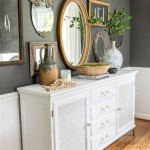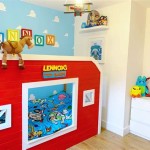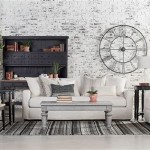How To Decorate My Big Living Room
Decorating a large living room presents both opportunities and challenges. The expansive space allows for greater flexibility in furniture arrangement and design choices, but it also necessitates careful planning to avoid creating a room that feels empty, cold, or disjointed. This article will provide a comprehensive guide to decorating a large living room effectively, focusing on key principles of space planning, furniture selection, color palettes, and accessorizing.
Space Planning and Zoning
The first step in decorating a large living room is to strategically plan the use of space. Large rooms often benefit from being divided into distinct zones, each serving a different purpose. This creates a more functional and visually appealing environment. Consider the various activities that will occur in the living room, such as conversation, relaxation, entertainment, and perhaps even a workspace. Clearly defined zones will help to avoid a sprawling, undefined feel.
One common approach is to create a conversation area centered around a focal point, such as a fireplace or a large window. This zone typically includes a sofa, armchairs, and a coffee table, arranged to facilitate comfortable interaction. Another zone might be dedicated to entertainment, featuring a television, media console, and comfortable seating for watching movies or playing games. A separate reading nook could be created with a comfortable chair, a floor lamp, and a bookshelf. If the living room is large enough, a small home office area could be incorporated, with a desk, chair, and appropriate lighting.
Visual cues can be used to define these zones without physically partitioning the room. Area rugs are particularly effective for delineating different areas. For example, a large rug underneath the conversation area will anchor the furniture and visually separate it from the rest of the room. Furniture placement can also play a role in defining zones. Placing a sofa or a console table with its back facing another zone can create a subtle barrier.
Traffic flow is another crucial consideration in space planning. Ensure that there are clear pathways through the room, allowing people to move easily between different areas. Avoid placing furniture in a way that obstructs these pathways. Consider the placement of doorways and windows when planning the layout. Natural light is a valuable asset and should be maximized. Avoid blocking windows with large pieces of furniture.
Scale is also important. In a large room, small furniture can get lost and appear insignificant. Choose furniture pieces that are appropriately sized for the space. A large sectional sofa, for example, may be a better choice than a small loveseat. Similarly, consider using larger artwork and accessories to avoid a cluttered or sparse appearance.
Furniture Selection and Arrangement
Selecting the right furniture is essential for creating a comfortable and stylish large living room. Consider the overall style of the room and choose furniture that complements that style. Whether the room is modern, traditional, or eclectic, the furniture should reflect the desired aesthetic. As previously mentioned, scale is paramount. Opt for larger pieces that fill the space appropriately.
A sectional sofa is often a good choice for a large living room, as it provides ample seating and can help to define the conversation area. Alternatively, two sofas facing each other, with armchairs flanking each end, can create a more formal and balanced arrangement. Consider the depth and height of the sofas, ensuring that they are comfortable and proportionate to the room. Avoid sofas that are too low to the ground, as they may appear dwarfed in a large space.
Choose chairs that complement the sofas in terms of style and scale. Armchairs provide additional seating and can add visual interest to the room. Consider using a mix of different chair styles to create a more eclectic and personalized look. Ottomans are also a versatile addition to a large living room. They can be used as footrests, extra seating, or even as coffee tables.
The coffee table is a central element in the conversation area. Choose a coffee table that is appropriately sized for the sofas and chairs that surround it. A large coffee table can serve as a focal point and provide ample space for drinks, books, and other items. Consider the shape of the coffee table as well. A rectangular coffee table is a classic choice, but a round or oval coffee table can soften the lines of the room and create a more inviting atmosphere.
In addition to seating and coffee tables, consider incorporating other pieces of furniture that add functionality and style to the room. Console tables can be placed against walls to provide storage and display space. Bookshelves can be used to create a reading nook or to display decorative items. Media consoles are essential for housing the television and other electronic equipment. Choose furniture pieces that are well-made and durable, as they will likely be used frequently.
Arranging furniture effectively is crucial for maximizing the use of space and creating a comfortable and inviting atmosphere. Avoid pushing all the furniture against the walls, as this can create a feeling of emptiness. Instead, float the furniture away from the walls to create a more intimate and engaging space. Experiment with different arrangements until you find one that works best for your room.
Color Palettes, Lighting, and Accessories
The color palette of a large living room plays a vital role in setting the mood and creating a cohesive design. Light colors can make a room feel more spacious and airy, while dark colors can create a more intimate and cozy atmosphere. Consider the amount of natural light in the room when choosing a color palette. If the room receives plenty of natural light, you can experiment with darker colors. If the room is darker, stick to lighter colors to brighten it up.
A neutral color palette is a safe and versatile choice for a large living room. Neutral colors, such as white, beige, gray, and cream, provide a calming backdrop for other elements in the room. They also allow you to easily incorporate pops of color through accessories, artwork, and textiles. A monochromatic color scheme, using different shades of the same color, can also create a sophisticated and elegant look.
If you want to add more color to the room, consider using accent colors. Accent colors can be used in small doses to add visual interest and personality to the space. Choose accent colors that complement the neutral base color and reflect your personal style. Popular accent colors for living rooms include blue, green, yellow, and orange. These colors can be incorporated through throw pillows, blankets, artwork, and other accessories.
Lighting is essential for creating a comfortable and functional living room. A well-lit room feels more inviting and can be used for a variety of activities. Consider using a combination of different types of lighting, including ambient lighting, task lighting, and accent lighting. Ambient lighting provides overall illumination to the room, while task lighting is used for specific activities, such as reading or working. Accent lighting is used to highlight architectural features or artwork.
Overhead lighting, such as chandeliers or recessed lighting, can provide ambient lighting to the room. Table lamps and floor lamps can be used to provide task lighting and to create a warm and inviting atmosphere. Consider using dimmer switches to adjust the lighting levels according to your needs. Natural light is also important. Keep windows clean and unobstructed to maximize the amount of natural light in the room.
Accessories are the finishing touches that add personality and style to a living room. Choose accessories that reflect your personal taste and complement the overall design of the room. Consider using a mix of different textures, patterns, and colors to create visual interest. Throw pillows and blankets can add comfort and warmth to the seating area. Area rugs can define different zones and add color and pattern to the floor. Artwork can add visual interest and personality to the walls.
Plants can bring life and vibrancy to a living room. Consider using a variety of different plants, including potted plants, hanging plants, and floor plants. Choose plants that are appropriate for the amount of light in the room. Mirrors can also be used to enhance the space. Mirrors can reflect light and make a room feel larger and brighter. Place mirrors strategically to maximize their impact.
Scale is important when choosing accessories. In a large room, small accessories can get lost and appear insignificant. Choose accessories that are appropriately sized for the space. Large artwork, for example, can make a statement and fill a large wall. Similarly, large vases and sculptures can add visual interest to a room.

13 Tricks To Decorating A Large Living Room

How To Decorate A Large Living Room Make It Feel Cosy High Ceiling Orange Big Wall Decor

10 Essential Ideas For Decorating Large Walls The Unlikely Hostess Wall Decor Living Room Family

Three Simple Wall Of Art Ideas Farm House Living Room Small Decor Interior Design

12 Affordable Ideas For Large Wall Decor Birkley Lane Interiors

Here Are The Secret Tips For Success In Decor Large Wall Chicnchill

How To Decorate A Big Blank Wall Sanctuary Home Decor

13 Tricks To Decorating A Large Living Room

Thrifty And Chic Diy Projects Home Decor

Tour The Beautiful 2025 Southern Living Idea House In Bluffton South Ina Room Furniture Layout Long Hamptons







